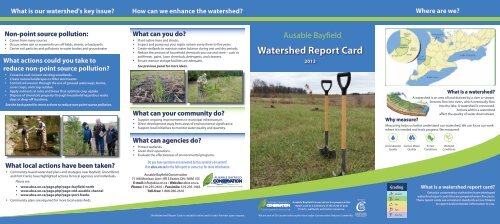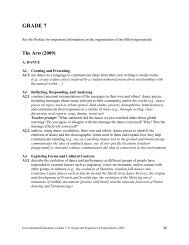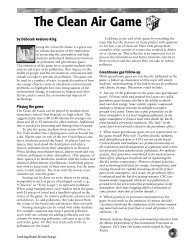Watershed Report Card - Ausable Bayfield Conservation Authority
Watershed Report Card - Ausable Bayfield Conservation Authority
Watershed Report Card - Ausable Bayfield Conservation Authority
Create successful ePaper yourself
Turn your PDF publications into a flip-book with our unique Google optimized e-Paper software.
What is our watershed's key issue?How can we enhance the watershed?Where are we?Non-point source pollution:• Comes from many sources• Occurs when rain or snowmelt runs off fields, streets, or backyards• Carries soil particles and pollutants to water bodies and groundwaterWhat actions could you take toreduce non-point source pollution?• Conserve and connect existing woodlands.• Create natural landscapes to filter stormwater.• Control soil erosion through the use of grassed waterways, berms,cover crops, and crop residue.• Apply nutrients at rates and times that optimize crop uptake.• Dispose of chemicals properly through household hazardous wastedays or drop-off locations.See the back panel for more actions to reduce non-point source pollution.What can you do?• Plant native trees and shrubs.• Inspect and pump out your septic system every three to five years.• Create wetlands to maintain water balance during wet and dry periods.• Reduce the amount of household chemicals you use and store – such asantifreeze, paint, lawn chemicals, detergents, and cleaners.• Ensure manure storage facilities are adequate.See previous panel for more ideas.What can your community do?• Support ongoing improvements to municipal infrastructure.• Direct development away from areas of environmental significance.• Support local initiatives to monitor water quality and quantity.<strong>Ausable</strong> <strong>Bayfield</strong><strong>Watershed</strong> <strong>Report</strong> <strong>Card</strong>2013Why measure?What is a watershed?A watershed is an area of land drained by a river or stream.Streams flow into rivers, which eventually flowinto the lake. A watershed is connected.Actions within a watershedaffect the quality of water downstream.Measuring helps us better understand our watershed. We can focus our workwhere it is needed and track progress. We measured:What can agencies do?• Protect wetlands.• Green their operations.• Evaluate the effectiveness of environmental programs.GroundwaterQualityWaterQualityForestConditionsWetlandConditionsWhat local actions have been taken?• Community-based watershed plans and strategies near <strong>Bayfield</strong>, Grand Bend,and Port Franks have highlighted actions for local agencies and individuals.Please see:• www.abca.on.ca/page.php?page=bayfield-north• www.abca.on.ca/page.php?page=old-ausable-channel• www.abca.on.ca/page.php?page=port-franks• Community plans are required for more local watersheds.Do you have questions not answered by this summary document?Visit abca.on.ca for the full report or contact us for more information:<strong>Ausable</strong> <strong>Bayfield</strong> <strong>Conservation</strong>71108 Morrison Line • RR 3 Exeter, ON • N0M 1S5E-mail: info@abca.on.ca • Website: abca.on.caPhone: 519-235-2610 • Facsimile: 519-235-1963Toll-free: 1-888-286-2610The <strong>Watershed</strong> <strong>Report</strong> <strong>Card</strong> is available online and in other formats upon request.<strong>Ausable</strong> <strong>Bayfield</strong> <strong>Conservation</strong> has prepared thisreport card as a summary of the state of yourforests, wetlands, and water resources.We are one of 36 conservation authorities under <strong>Conservation</strong> Ontario's umbrella.SurfaceGradingA ExcellentB GoodC FairD PoorF Very PoorWhat is a watershed report card?Ontario’s conservation authorities have developedwatershed report cards that are prepared every five years.These report cards use consistent standards across Ontarioto report environmental information to you.
Groundwater QualitySurface Water QualityForest ConditionsWetland CoverConcentrations of nitrate and chloride were measured at 14 Ontario Ministry ofthe Environment monitoring wells. (Learn about groundwater at sourcewaterinfo.on.ca)What did we find?• Nitrate and chloride concentrations are better than the drinking waterguidelines in most wells (A grade).• Concentrations of nitrate and chloride approach or exceed the drinking waterguidelines at some wells, resulting in a poorer grade (less than A grade).• The quality of your well water may vary from that of the monitoring wells. Insome instances, the location of wells was chosen to monitor local issues.Concentrations of phosphorus and Escherichia coli (bacteria) were measured atOntario Ministry of the Environment and <strong>Ausable</strong> <strong>Bayfield</strong> <strong>Conservation</strong> stations.Benthic invertebrates (small aquatic animals living in the sediment) were alsoidentified. The type and number of these animals are measures of water quality.What did we find?• Grades range from A to D, with mostly C grades.• Most watersheds remain steady – since the last reporting period – however,there have been improvements within the Bannockburn and Main <strong>Bayfield</strong>watersheds. (Visit abca.on.ca to compare 2007 and 2013 report cards).The percentages of forest cover, forest interior, and streamside cover weremeasured with Geographic Information Systems (GIS).What did we find?• Grades range from A to D, with mostly D grades.• Forests grow slowly, but environmental benefits begin as soon as trees areplanted. Changes in forest cover will be noticed in five years or more.For more details about the information found in these maps, visit abca.on.caor contact us. You can find our contact information on the back panel.The percentage of wetland cover was measuredwith Geographic Information Systems (GIS).What did we find?• Grades range from B to F, with mostly F grades.• Only 2.4 per cent of the <strong>Ausable</strong> <strong>Bayfield</strong> area iscovered by wetlands.• More wetlands are needed in strategiclocations across local watersheds.





